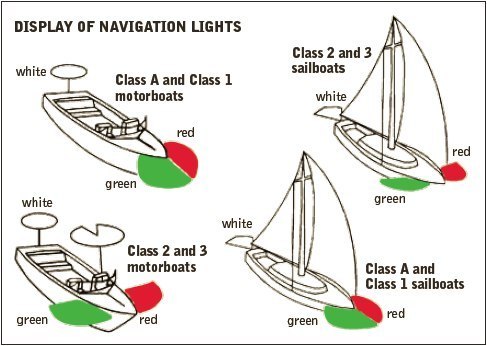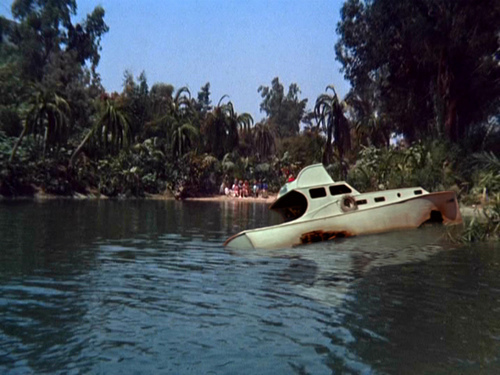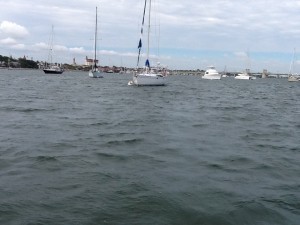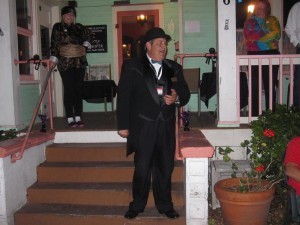Mike Jastrzebski's Blog, page 14
November 11, 2014
Red Right Returning

Red right returning, a basic element of the boating rules of the road that nearly everyone remembers. At least until they get on the water.
Up here in New England, this year’s recreational boating season has concluded. A cold front linked to a storm off Alaska will soon bring in frigid air, and the days are growing shorter. This all makes for an ideal time for boaters to freshen-up on the navigational rules of the road. Twenty minutes each night with the 67th edition of Chapman Piloting and Seamanship and we’ll all be navigational wizards by Spring. In theory, that is.
The fundamental problem with boating rules of the road is that they require a key element often missing – reciprocity. On land, reciprocity comes in the form of one car staying to the right side of the road, while the oncoming car does the same. In a world of reciprocity on the water, you would keep the red buoy to your right as you return to port while an outgoing boat stays to the side of the channel marked by a green buoy. Unfortunately, several factors undermine this ideal state. Let’s face it, some boaters find it just too hard to identify buoys of any color when their five kids are sitting in the front of the boat with their feet hanging over the bow. Others are overcome by distractions – sunscreen that needs to be applied, fishing rods that require rigging, beer coolers that need tending. And sometimes, as when life jackets that need to be stowed in inaccesible lockers, it’s just too hard to stay at the wheel while the boat is underway. And that’s before we’ve even begun to discuss electronics.
Yet before I take you on a rant about other boaters, let me be the first to acknowledge that I need the offseason brush-up as much as anyone. For example, recently I spotted the below depiction of inland markers used in Maine and noticed the yellow marker at the bottom that indicates the presence of Milfoil.
In the quiet of the off-season, I can Google Milfoil, learn that it’s vegitation and know that I will retain this factoid for an annoyingly long period of time (while I forget the really important information that will save me from landing me on the rocks as I approach Newport on a foggy night).
In my heart of hearts I also know that my need for off-season tutelage isn’t limited to some obscure inland channel buoys. Every once in a while I need to remember that when it comes to running lights, that line about red and right doesn’t fit – the red bow light is on the left side – the port side. Port wine is red is one memory tool that can help you out. And when I am down in Florida on the Intracoastal, the green markers will be on the Gulf side of the channel – green on Gulf being the memory tool for that one.

So here I sit, ready to sharpen my knowledge, hastened by the fact all skippers have had their navigational skills tested while at sea. Study I will over the winter months, imaging hours on the water, remembering that the even saltiest of captains have run afoul, in some instances on trips as short as a Three Hour Tour.

by John Urban
Share on Facebook
November 9, 2014
It’s writing time again.

By Mike Jastrzebski
We’ve been in the mooring field here in St. Augustine for a little over three weeks and we’ve fallen into a routine that allows me to write on the days Mary works (3 days a week), and the day she does laundry. So far, I have finished about a third of the third draft of Stranded Naked Blues.
The other three days are spent shopping, doing regular maintenance on the boat, and taking care of my dental appointments. We’ve also managed to go to the cruiser’s net gatherings and do a little sightseeing on our own.
I think that with this four day writing schedule I should be able to complete the book by the first of the year. all of my books have gone through five to seven drafts before I published the books and I expect this book to follow that pattern.
After I finish this draft I will read the book out loud and revise as I read. After that Mary will do a line edit and if she finds any discrepancies or areas that don’t quite work for her I will fix the problems and then hopefully the book will be ready to publish.
Wish me luck.
Share on Facebook
November 7, 2014
Flotsam & jetsam

by Christine Kling
I’ve been sitting here for the better part of the morning trying to focus on writing my blog. We are back off the town of Majuro and back into the noise and chaos of the town. I try one blog idea, and it peters out. So, rather than spend the rest of the day here, I’m going to do one of my flotsam & jetsam blogs which will always be a compendium of the things on my mind, recommendations for great reads, rants or whatever.
First up, I’d like to give kudos to my husband-to-be Wayne for something he accomplished this past week. I really think it’s great when cruisers can give something back to the community ashore. And it’s better yet when helping them also helps us. We love to hang out at Eneko Island which has a little very rustic resort called Eneko Island Get Away that is owned by the Robert Reimers Hotel back in Majuro. We learned that the folks out there had a solar panel and four 8D gel batteries donated to them that they wanted to get hooked up to run their Internet hot spot. They didn’t have a solar controller, though, and they wanted to set up the panel and batteries on one building while the hot spot equipment was on another building. Missing parts and lacking know-how, nothing was happening. Enter Wayne — who donated a used controller he had kept as a back-up when he upgraded the boat, and then he spent three days ashore with his tool bag (and the heat and mosquitos) getting the whole thing working. He even relocated the wifi sending and receiving equipment. Now, the residents there don’t have to run the generator to get internet for themselves or their guests, and we get to have wifi as well out on our boat. Win-win.
Second, I have been growing more and more interested in weather and trying to learn how the wind patterns and cyclone seasons work out here in the Pacific. Our friend Philip on the yacht Blue Bie shares lots of weather links with us and this one is absolutely beautiful. Check out this animated rendering of the GFS prediction model of the world’s winds. You can click and move around the world. It’s great fun. Play with it!
Third, I’d like to help get the word out about a great deal on a Kindle bundle of books for any self-publishing writers. Called The Indie Author Power Pack, it is a fantastic deal – only 99c – and contains three top rated writer’s guides. I already owned two of the books, but I bought the set anyway just to get Joanna Penn’s book on marketing. Any one of the three is a great deal and it’s available on Amazon, Apple, B&N, and Kobo. The three books are:
Write. Publish. Repeat. by Sean Platt & Johnny B. Truant
Let’s Get Digital (2nd ed.) by David Gaughran
How To Market a Book (2nd ed.) by Joanna Penn
If you would like more information about this bundle, and or direct links to all the vendor’s sites, check out David’s blog here.
For my last bit of cool stuff, I have another book. As one who subscribes to Lin Pardey’s newsletter, I learned that Lin is bringing one of my favorite sea story books back into print. It’s called Blown Away by Herb Payson. Herb and his wife were sailing in the South Pacific at the same time Jim and I were back in the 1970’s, and so I had to buy the original book when it first came out. This book is laugh out loud funny, and anyone who has cruised will identify with the fixes cruisers can find themselves in. Lin and Larry Pardey are bringing out a 30th anniversary edition of the book (including an ebook) that will be available on Dec. 15. I recommend you all put it on your TBR lists or on your Christmas gift lists.
Time to get back to writing my book!
Fair winds!
Christine
Share on Facebook
November 6, 2014
Bad Characters…
C.E. Grundler
It’s been said that you can have the best story in the world, but if your characters aren’t interesting, real people, you’re dead in the water. And the opposite holds true as well: you could have a perfectly generic story, but if readers are drawn in and connect to your characters, you’ve won them over. And it’s true that readers want conflict. They want to see suffering, anguish, joy, and so on. Books are an amusement park for the brain, and they’re on line for the Cyclone. Hit them with ever lift, dip, hairpin twist, and leave them exhilarated from the ride.
But in order to get readers aboard and invested, rather than passively watching from the sidelines, this ride, no matter how extreme, must have some relatable elements. Consider ‘relatable’ like the cars on the coaster. They’re what keep you rolling along and on track as each twist blindsides you. For us as humans, relatable means familiar — and you can establish familiar even in the most alien settings. It all comes back to the strength of your characters.
I’ve been reading a number of psychology text books (not writing books) on dealing with difficult, emotional, irrational, unpredictable people. Several of my characters fall into that category — and those are their good qualities. Through this reading blitz I’ve come to one conclusion: we’re ALL difficult,emotional, irrational, unpredictable people. It’s called being human. There are plenty of lessons we can take from that, especially if we hold a mirror up to ourselves, and the more we understand the more we can apply these lessons to our characters, ourselves, and those around us. Understand those traits and behaviors that cause us and our readers to respond with strong emotions, then let your characters say and do all the wrong things, and whether they be on a failing space station or hiking Donner Pass in January, and your readers will be there with them. Your book can take them to places they’ve never been, all the while grounding them in familiar emotions, be they happiness, fear, dread, panic, and so on. After all, we all say and do the wrong things, over or under-react, fly off the handle for a myriad of reasons, and if those motivations are at the core of your character’s behavior, your story will be stronger for it.
Share on Facebook
November 2, 2014
Ghost walking in St. Augustine.
By Mike Jastrzebski
One of the nice things about being in St. Augustine is the cruiser’s net. Along with broadcasting weather and boating information every morning at 9 a.m., the people who broadcast the net do a good job of organizing cruiser’s get-together’s.
On Halloween a group of us met at the Cruisers Grill for burgers and beer, then we headed over to Ancient City Ghost Tours for a tour of where the ghosts hang out in St. Augustine. Now don’t get me wrong, I don’t believe in ghosts, but Mary wanted to go and we were able to get half off tickets, so a-walking we did go.
Our tour guide, Jim.

Jim is a true storyteller and and as you can well imagine, a town that was founded in 1565 is bound to have it’s share of ghost stories. Jim managed to keep us mesmerized throughout the hour-and-a-half walk, and what more could you ask for on a ghost tour, except maybe a real ghost or two.
On our walk we learned about the woman in white, a ten year old boy who’s deadly journey started in a graveyard, and a deadly love affair that resulted in the live entombment of an unfaithful wife and her lover in a secret room in the Castillo de San Marcos.
The tree where the boy’s ghost is supposed to appear occasionally.

The Castillo de San Marcos.

And finally, a good old fashioned graveyard.

Did this tour change my opinion about ghosts? No, I’m still a nonbeliever. Did I enjoy the tour? Hell yes, I never could pass up a good story, or two, or three.
Share on Facebook
October 31, 2014
I just need to get away from it all . . .

You know things are getting crowded when this anchors behind you
by Christine Kling
Okay, stop with the eye roll, okay. Yes, I know, I am living on a sailboat located in the Marshall Islands smack in the middle of the Pacific Ocean, but hey, everything is relative, right?
Writing is difficult enough, but trying to concentrate here on our mooring off the town of Majuro is getting more and more difficult. This place has become crazy crowded compared to what it was like a couple of months ago when we returned from our big trip abroad. The moment when I knew I just had to get away came on Tuesday when I saw an unusual-looking white boat far out in the lagoon. We’re used to all the dozens of the big purse seiners here, but this one looked more like a yacht. I grabbed the binoculars and sure enough, it was a pretty big looking motor yacht. When she pulled in and anchored a few hundred yards off our boat, we could make out her flag (Cayman Islands) but not the name. But soon our friend Philip sailed by her on his Outremer Catamaran on his way back from Eneko, and he emailed Wayne that the yacht (as seen in the photo above) was called Senses and she belonged to none other that Google founder Larry Page.

The lagoon is filling up
Since we arrived here we have also seen the arrival of four cruising sailboats. The Marshall Islands are a refuge at this time of year. Many boats love to sail the islands of the South Pacific: French Polynesia, the Cook Islands, Tonga, Fiji, etc. but just like off the tropical coasts of North America, the South Pacific spawns cyclones — or hurricanes as they are called in North America. The South Pacific season is the opposite of the North American season, so while friends of mine are getting ready to leave Trinidad and Grenada, here in Majuro, the place is starting to fill up. Statistically speaking, the areas found ten degrees to the north and south of the equator have few enough cyclonic storms to be considered “safe zones,” so that is why folks head south to Trinidad or north to the Marshall Islands out here. The other choice is to head to higher latitudes like New Zealand, but just like heading north up the east coast, it puts the boats having to cross lots of open water on the shoulder season between cyclones and winter storms.
While the Marshall Islands are part of Micronesia, they are not so far west as to be in the cyclone areas of the Northeast Pacific like some of the other Micronesian islands further west of us. I don’t really understand the various seasons there yet. In the Philippines, for example, there is never a time when it’s not a cyclone season in some part of that huge island country. Two of the boats that arrived here recently came from the west of us in Micronesia. Both boats have families on board, but we don’t see much of them nor so they take part in the morning cruiser’s net on the radio. Apparently, they are Jehovah’s Witnesses and they are missionary boats. We do see lots of different folks out here cruising.
 Part of the reason why it is so noisy here is because we are moored directly off the docking areas for all the small shore boats. For the big tuna fleet, Uliga Dock is the place where the fishing officials have their offices and they have to go out to greet and inspect all the boats that come in. The pilot boat is there, too. Then once the tuna boats are cleared, they often anchor before they unload and they use their big net boats with 1200 HP air-cooled engines to ferry crew and provisions back and forth out to the boats. Then there are the dinghies from the yachts and the outboard fishing boats owned by the Marshallese. Sometimes it feels like over a hundred boats zip around us every day and if they get within about 100 feet of Learnativity, they set off the canine alarm system.
Part of the reason why it is so noisy here is because we are moored directly off the docking areas for all the small shore boats. For the big tuna fleet, Uliga Dock is the place where the fishing officials have their offices and they have to go out to greet and inspect all the boats that come in. The pilot boat is there, too. Then once the tuna boats are cleared, they often anchor before they unload and they use their big net boats with 1200 HP air-cooled engines to ferry crew and provisions back and forth out to the boats. Then there are the dinghies from the yachts and the outboard fishing boats owned by the Marshallese. Sometimes it feels like over a hundred boats zip around us every day and if they get within about 100 feet of Learnativity, they set off the canine alarm system.

The canine alarm system ready to go off next to Philip’s ear
This alarm system is usually sleeping on the top of the coaming about 12 inches away from our ears when we are working in the cockpit where it is coolest. This is the most enthusiastic alarm system you have ever seen. The two of them are never happier than when some high-pitched outboard comes screaming into earshot. Sometimes Barney gets so excited he runs to the bow and just keeps running in circles barking in pure canine bliss. I don’t know which is worse, the noise from the boats or the canine alarm system.
 So, we are planning to leave this afternoon and make our way back out to Eneko, the lovely little island you can see on the chart above. It’s quiet and the canine security system goes silent, too, barking only when somebody says the word “beach.” Eneko is on the north side where the little hump is and in this view it shows 66.4 and 181 foot depths offshore. The local yacht club put down moorings off the island so we swing between 45 and 100 feet there depending on the wind direction. As you can see from the soundings, most of the lagoon is too deep for yachts like us to anchor. It’s not a problem for the tuna boats or Google, though. On the chart you can also see the well-marked pass into this atoll. That’s another thing that makes this place such a draw for boats of all kinds. It’s easy to enter, provides shelter and there is a lively town ashore with supermarkets, restaurants and hardware stores.
So, we are planning to leave this afternoon and make our way back out to Eneko, the lovely little island you can see on the chart above. It’s quiet and the canine security system goes silent, too, barking only when somebody says the word “beach.” Eneko is on the north side where the little hump is and in this view it shows 66.4 and 181 foot depths offshore. The local yacht club put down moorings off the island so we swing between 45 and 100 feet there depending on the wind direction. As you can see from the soundings, most of the lagoon is too deep for yachts like us to anchor. It’s not a problem for the tuna boats or Google, though. On the chart you can also see the well-marked pass into this atoll. That’s another thing that makes this place such a draw for boats of all kinds. It’s easy to enter, provides shelter and there is a lively town ashore with supermarkets, restaurants and hardware stores.
At Eneko, they do have a hot spot for the local Internet, but what they don’t have is power. For a while their generator had broken down. That was what prevented me from posting a blog last week. However, we’ve learned they have bought a solar panel and Wayne has volunteered to donate an old solar controller as well as his labor to mount and connect the panel. If we can get Internet at Eneko all the time, we might not come back to town until the fridge or the wine locker is empty, whichever comes first. We’ll revel in the peace and quiet and hopefully, my writing output will improve.
Just so long as nobody says the word “beach.”
Fair winds!
Christine
Share on Facebook
October 30, 2014
Staying Focused…
C.E. Grundler
The challenge with having too many things going on in your life simultaneously is staying focused on any one single task. To sell this house I’ve got to straighten it up. But as I work on that, my mind’s on my writing. That’s the best part of writing, and its downside as well — you’re always thinking about it whether you’re writing or not. But everywhere I turn I see yet another thing on the house to-do list, which needs to be done if I’m every going to move onto the boat — oh, wait, another to-do list as well. It seems these days no matter which way I turn, something is clamoring for my attention. Which, I suppose explains the screaming headache I woke with and haven’t been able to shake, which makes focusing all the more difficult. Which in turn explains the briefness of this post.
Livin’ the dream(?) can be hard work sometimes.
Share on Facebook
October 27, 2014
Zeke Emanuel, Creativity & Aging
Dr. Ezekiel Emanuel succeeded in starting a discussion. His article in The Atlantic “Why I Hope to Die at 75” is intended to startle the reader, and it does.
As head of the Department of Medical Ethics & Health Policy at the University of Pennsylvania, Emanuel speaks with authority. As the older brother of Chicago Mayor Rahm Emanuel and Hollywood agent Ari Emanuel (who inspired the character Ari Gold on the HBO series Entourage), the man also possesses first rate genes for attention getting.
The title of the article is, however, a bit misleading in that Emanuel’s main premise is: “Once I have lived to 75, my approach to my health care will completely change. I won’t actively end my life. But I won’t try to prolong it, either.”
Aside from the merits of his arguments or speculation on whether or not he will change his views as he ages, it was Emanuel’s ascent into the realm of creativity that caught my attention.
He writes: “(B)y 75, creativity, originality, and productivity are pretty much gone for the vast, vast majority of us.” Emanuel goes on to cite research that supports this assertion and adds a quote from Einstein: “A person who has not made his great contribution to science before the age of 30 will never do so.”
I might be sympathetic to Emanuel’s underlying belief that we are overly focused on extending life, and I am open to research that provides statistical analysis to help us better understand outcomes, but I am slow to get on board with his generalizations about creativity.
As someone involved in fiction writing, I am often asked where I get my ideas. I wish I knew, but I am comfortable in knowing that I have yet to meet a fellow-writer who possesses a good answer to this question. The fact is, we don’t understand much of anything about the origins of creative writing, not to mention identifying the sweet-spot in life for penning good works. Authors such as Raymond Chandler and Laura Ingalls Wilder didn’t start until their mid-40s, and I know from having attended writers’ conferences that many older writers exhibit vibrant careers, some just getting into writing in their retirement years.
I am tempted to take exception to Emmanuel’s statement on creativity, but I don’t really feel the need for one simple reason: writers will write – that’s what they do and they won’t stop because a researcher presents an opinion concerning the bell curve of creative output.
If I live another twenty years and turn 75, I may well still be writing. And even if Emanuel is right about an expiration of creativity, I might happen to be a bit wiser, a bit more advanced in my understanding.
Stephen King is known for saying “Fiction is a lie, and good fiction is the truth inside the lie.” Perhaps the wisdom of age will get me closer to those truths and, in turn, produce good fiction. Either way, I hope I’m still going, regardless of what Emanuel or anyone else says. But that’s all in the future. Until then, I hope to wake up tomorrow, look around, take in life, and maybe, just maybe, get a few creative words on paper. With any luck, maybe even capture some truth.
by John M. Urban
Share on Facebook
Zeke Emmanuel, Creativity & Aging
Dr. Ezekiel Emanuel succeeded in starting a discussion. His article in The Atlantic “Why I Hope to Die at 75” is intended to startle the reader, and it does.
As head of the Department of Medical Ethics & Health Policy at the University of Pennsylvania, Emanuel speaks with authority. As the older brother of Chicago Mayor Rahm Emanuel and Hollywood agent Ari Emanuel (who inspired the character Ari Gold on the HBO series Entourage), the man also possesses first rate genes for attention getting.
The title of the article is, however, a bit misleading in that Emanuel’s main premise is: “Once I have lived to 75, my approach to my health care will completely change. I won’t actively end my life. But I won’t try to prolong it, either.”
Aside from the merits of his arguments or speculation on whether or not he will change his views as he ages, it was Emanuel’s ascent into the realm of creativity that caught my attention.
He writes: “(B)y 75, creativity, originality, and productivity are pretty much gone for the vast, vast majority of us.” Emanuel goes on to cite research that supports this assertion and adds a quote from Einstein: “A person who has not made his great contribution to science before the age of 30 will never do so.”
I might be sympathetic to Emanuel’s underlying belief that we are overly focused on extending life, and I am open to research that provides statistical analysis to help us better understand outcomes, but I am slow to get on board with his generalizations about creativity.
As someone involved in fiction writing, I am often asked where I get my ideas. I wish I knew, but I am comfortable in knowing that I have yet to meet a fellow-writer who possesses a good answer to this question. The fact is, we don’t understand much of anything about the origins of creative writing, not to mention identifying the sweet-spot in life for penning good works. Authors such as Raymond Chandler and Laura Ingalls Wilder didn’t start until their mid-40s, and I know from having attended writers’ conferences that many older writers exhibit vibrant careers, some just getting into writing in their retirement years.
I am tempted to take exception to Emmanuel’s statement on creativity, but I don’t really feel the need for one simple reason: writers will write – that’s what they do and they won’t stop because a researcher presents an opinion concerning the bell curve of creative output.
If I live another twenty years and turn 75, I may well still be writing. And even if Emanuel is right about an expiration of creativity, I might happen to be a bit wiser, a bit more advanced in my understanding.
Stephen King is known for saying “Fiction is a lie, and good fiction is the truth inside the lie.” Perhaps the wisdom of age will get me closer to those truths and, in turn, produce good fiction. Either way, I hope I’m still going, regardless of what Emanuel or anyone else says. But that’s all in the future. Until then, I hope to wake up tomorrow, look around, take in life, and maybe, just maybe, get a few creative words on paper. With any luck, maybe even capture some truth.
by John M. Urban
Share on Facebook
St. Augustine
By Mike Jastrzebski
We’ve been in St. Augustine for nearly two weeks now and I have to admit that it’s a pleasant place. As much as we would like to head south, we’ve decided to stay here for awhile.
The bus service has been great for getting around and for seniors the cost is only .50 cents. There are also a lot of taxies here and they are reasonable. We took a taxi to the endodontist and it was only ten bucks.
That’s right, an endodontist. I needed to get a root canal and I need a new bridge so I really need to get a couple of books done to feed the cruising kitty. With that in mind Mary took a part time job working at the Panama Hat shop here in town.
Her working will get her off the boat a couple of days a week and allow me to write without distraction. If you’ve ever tried writing with someone moving around in a small space you know what I mean.
It’s almost nine and time for the St. Augustine cruisers’ net, then I have to fire up the computer and start writing, so it’s time to wrap this up.
Share on Facebook




